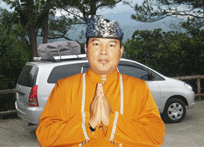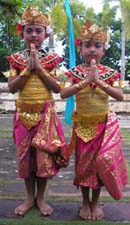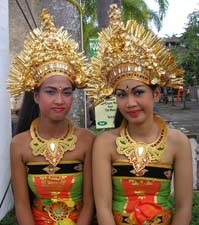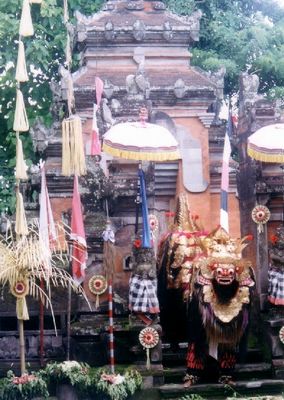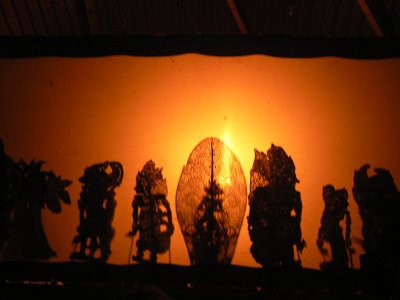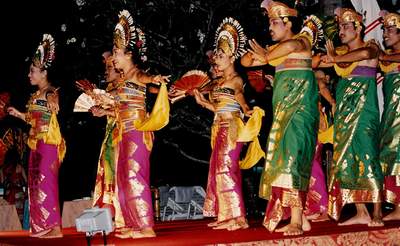
|
Home » My Services » Balinese Dance Balinese Dance Dear Visitor, Bali Offers many attraction which is very intersting to visit and see.Once which is very special are Balinese traditional dance.There are a Balinese dances which connected with the Hinduism religion ceremony.Besides that ,there are Balinese dances which also related with the religion ceremony but can be showed as a solace for society people.These kind of dances are the dances that can be showed.
Knowing that it is difficult to enjoy something you do not understand, we've outlined a few of the more popular dances below. These dances have chosen because they showcase a wide variety of dance styles, use different types of musical instruments to accompany them and because there are regularly scheduled performances that are easy to find. As you will notice most the dances revolve around the Ramayana epic. The difference is that different parts of the Ramayana story are used to suit different types of music and dances (i.e. romance, war, moral story etc.) When performed in the villages during important ceremonies some of these dances may well go on for hours - but the regularly scheduled performances last about one hour. We encourage you to see as many dances as possible - they are after all one of the reasons Bali is so special and your interest will help ensure that tradition of Balinese dance continues Barong Dance Set to the Gong Kebyar - an orchestra formed by a group of gamelan instruments (musical instruments with five notes forged from copper and bronze) and various metal gongs and symbols. The Barong dance is the classic story of good (The Barong) triumphing over evil ( The evil witch Rangda). The Barong is a large lion type creature played by two men, Rangda is the epitome of evil with long fingernails and droopy breasts. The Barong is going about his business until he is interrupted by Rangda. Ultimately a battle ensues and the Barong's followers begin attacking Rangda with their Keris (daggers). Rangda, being a witch, is able to use magical powers to turn the daggers against their owners, who fall into a trance and try to stab themselves. The Barong, also having magical powers, protects his followers from harm and Rangda retreats into the forest to rest and prepare for the next battle. The intensity of the Barong's followers in their attempts to stab themselves is really quite frightening and the trance is usually very real - and there is always a priest on hand to revive the dancers with holy water.
Legong Dance Also accompanied by the Gong Kebyar (see above), The Legong dance is perhaps the most graceful of Balinese dances. It is performed only by young girls 8-12 years old (after reaching puberty the girls usually stop performing this dance). Three girls perform the dance - 2 Legongs and an attendant. With their lithe bodies, the dance tells the tale of a certain princess Rangkesari who is held captive by King Laksmi. The princess' brother, Daha, tries to persuade King Laksmi to let his sister go. When the king refuses Daha, gathers an army together to force his sister's release. On his away to attack King Laksmi Daha is attacked by a crow. This proves to be a bad omen as later on Daha is killed in battle. Even though you never see the male characters the dance ends as the King leaves to fight Daha Kecak Dance This may be the most famous of Balinese dances but it is not a traditional dance. It was developed in the 1930's in the village of Bona specifically to cater to Western tastes. With no musical instruments accompanying this dance the dance troupe is "accompanied" by a large group of men (the more the better), naked from the waist up chanting ‘kechak-ke-chack'. The story of the dance is taken from the Ramayana epic and tells how the evil King Rahwana uses trickery to kidnap Rama's wife Dewi Sita and how Rama with the help of the white monkey army rescues his wife and defeats evil. While there are no trances or daggers flaying about this is still a very exciting dance to watch. Ramayana Ballet This is the full blown Ramayana epic adventure and is a spectacular dance replete with several characters all in different and gorgeous costumes. The story tells more or less the same story as the Kecak (see above) with one important difference - there is no Kecak "orchestra" rather the dancers are accompanied by a full 30 piece Gong Kebyar orchestra. Done well, this dance is not to be missed.
Makepung Often the Makepung dance is one part of a dance program with 3 or 4 short dances. Accompanied by the "Jegog" - another 5 note instrument but in this case made of very large pieces of bamboo. So large in fact that the musician must sit on top of the instrument in order to play it. Loud without being ear splitting the deep sound vibrates right through your body. Wayang Kulit The Wayang Kulit is not a dance per se but is still one of our favorites. The Wayang Kulit are Shadow puppets and this cultural treat is often overlooked by the tour operators because there are no flashy costumes. The "stage" is quite small - really only a bed sheet with a lantern illuminating it from behind so you will need to sit close. In this intimate night setting you will get a good idea of how this ancient tradition is still performed in the villages throughout Indonesia . This is Indonesian story telling at its best - and has often been used as a way to poke fun at the powers that be. Accompanied by a gamelan and drum and gong, the Dalang or puppet master commands up to 50 puppets made of flat pieces of dried leather. Since each puppet must have a different voice and have different characters (i.e. funny, smart, stupid, and so on) you can see why the Dalang is a clever man indeed.
TARI JANGER (JANGER DANCE) Along with the formal traditional dances, Balinese enjoy the ocassional fun "dance craze". The “Janger” is one such that actually survives today. It
appeared in the 1920's, and became hugely popular, with every village forming
groups. This maybe because it allows young women & men to dance together (sort of).
|
Copyright © 2002-2003 DriverBali - All Rights Reserve
Bali Driver - Bali Driver Guide - Bali Tour Driver - Bali Tour Guide - Bali Transport
